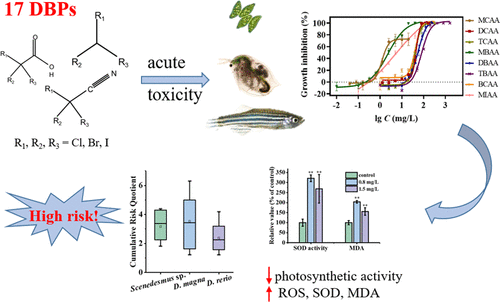当前位置:
X-MOL 学术
›
Environ. Sci. Technol.
›
论文详情
Our official English website, www.x-mol.net, welcomes your feedback! (Note: you will need to create a separate account there.)
Toxicity of 17 Disinfection By-products to Different Trophic Levels of Aquatic Organisms: Ecological Risks and Mechanisms
Environmental Science & Technology ( IF 11.4 ) Pub Date : 2021-06-16 , DOI: 10.1021/acs.est.0c08796 Huijun Cui 1, 2 , Baiyang Chen 1 , Yuelu Jiang 2 , Yi Tao 2 , Xiaoshan Zhu 2 , Zhonghua Cai 2
Environmental Science & Technology ( IF 11.4 ) Pub Date : 2021-06-16 , DOI: 10.1021/acs.est.0c08796 Huijun Cui 1, 2 , Baiyang Chen 1 , Yuelu Jiang 2 , Yi Tao 2 , Xiaoshan Zhu 2 , Zhonghua Cai 2
Affiliation

|
Intensified disinfection of wastewater during the COVID-19 pandemic increased the release of toxic disinfection by-products (DBPs). However, studies relating to the ecological impacts of DBPs on the aquatic environment remain insufficient. In this study, we comparatively investigated the toxicities and ecological risks of 17 typical, halogenated DBPs to three trophic levels of organisms in the freshwater ecosystem, including phytoplankton (Scenedesmus sp.), zooplankton (Daphnia magna), and fish (Danio rerio). Toxicity of DBPs was found to be species-specific: Scenedesmus sp. was the most sensitive to haloacetic acids, while D. magna was the most sensitive to haloacetonitriles and trihalomethanes. Specific to each DBP, toxicities were also related to their classes and substituted halogen atoms. Damage to photosystems and oxidative stress served as the potential mechanisms for DBPs toxicity to microalgae. The different sensitivities to DBPs indicate that a battery of bioassays with organisms at different trophic levels is necessary to determine the ecotoxicity of DBPs. Furthermore, the ecological risks of DBPs were assessed by calculating the risk quotients (RQs) based on toxicity data from multiple bioassays. The cumulative RQs of DBPs to all the organisms were greater than 1.0, indicating high ecological risks of DBPs in wastewater effluents.
中文翻译:

17种消毒副产物对不同营养水平水生生物的毒性:生态风险和机制
COVID-19 大流行期间对废水的强化消毒增加了有毒消毒副产物 (DBP) 的释放。然而,关于 DBPs 对水生环境的生态影响的研究仍然不足。在这项研究中,我们比较了 17 种典型的卤化 DBPs 对淡水生态系统中三个营养级生物的毒性和生态风险,包括浮游植物 ( Scenedesmus sp.)、浮游动物 ( Daphnia magna ) 和鱼类 ( Danio rerio )。发现 DBP 的毒性是物种特异性的:Scenedesmus sp。对卤乙酸最敏感,而D. magna对卤代乙腈和三卤甲烷最敏感。对于每个 DBP,毒性也与其类别和取代的卤素原子有关。对光系统和氧化应激的损害是 DBPs 对微藻毒性的潜在机制。对 DBP 的不同敏感性表明,需要对不同营养水平的生物进行一系列生物测定,以确定 DBP 的生态毒性。此外,DBPs 的生态风险是通过基于多个生物测定的毒性数据计算风险商 (RQ) 来评估的。DBPs 对所有生物的累积 RQs 大于 1.0,表明 DBPs 在废水中的生态风险很高。
更新日期:2021-08-03
中文翻译:

17种消毒副产物对不同营养水平水生生物的毒性:生态风险和机制
COVID-19 大流行期间对废水的强化消毒增加了有毒消毒副产物 (DBP) 的释放。然而,关于 DBPs 对水生环境的生态影响的研究仍然不足。在这项研究中,我们比较了 17 种典型的卤化 DBPs 对淡水生态系统中三个营养级生物的毒性和生态风险,包括浮游植物 ( Scenedesmus sp.)、浮游动物 ( Daphnia magna ) 和鱼类 ( Danio rerio )。发现 DBP 的毒性是物种特异性的:Scenedesmus sp。对卤乙酸最敏感,而D. magna对卤代乙腈和三卤甲烷最敏感。对于每个 DBP,毒性也与其类别和取代的卤素原子有关。对光系统和氧化应激的损害是 DBPs 对微藻毒性的潜在机制。对 DBP 的不同敏感性表明,需要对不同营养水平的生物进行一系列生物测定,以确定 DBP 的生态毒性。此外,DBPs 的生态风险是通过基于多个生物测定的毒性数据计算风险商 (RQ) 来评估的。DBPs 对所有生物的累积 RQs 大于 1.0,表明 DBPs 在废水中的生态风险很高。



























 京公网安备 11010802027423号
京公网安备 11010802027423号